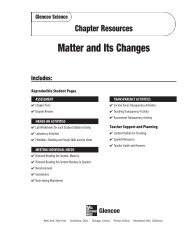chap11 - Learning Services Home
chap11 - Learning Services Home
chap11 - Learning Services Home
- No tags were found...
You also want an ePaper? Increase the reach of your titles
YUMPU automatically turns print PDFs into web optimized ePapers that Google loves.
Creep The process in whichsediments move slowly downhill,as shown in Figure 9A, is calledcreep. Creep is common wherefreezing and thawing occur. As iceexpands in soil, it pushes sedimentsup. Then as soil thaws, thesediments move farther downslope.Figure 10 shows how smallparticles of sediment can creepdownslope. Over time, creep canmove large amounts of sediment,possibly causing damage to somestructures. Do you live in an areawhere you can see the results ofcreep?CreepSoil or sedimentExpansion caused by freezingFalling caused by thawingTop of soilwhen frozenTop of soilwhen thawedSlump A slump occurs when a mass of rock or sedimentmoves downhill, leaving a curved scar, as shown in Figure 9B.Slumps are most common in thick layers of loose sediment, butthey also form in sedimentary rock. Slumps frequently occur onslopes that have been undercut by erosion, such as those abovethe bases of cliffs that have been eroded by waves. Slumping ofthis kind is common along the coast of Southern California,where it threatens to destroy houses and other buildings.Rock Slides Can you imagine millions of cubic meters ofrock roaring down a mountain at speeds greater than 250 km/h?This can happen when a rock slide occurs. During a rock slidelayers of rock break loose from slopes and slide to the bottom.The rock layers often bounce and break apart during movement.This produces a huge, jumbled pile of rocks at the bottom of theslope, as you can see in Figure 9C. Rock slides can be destructive,sometimes destroying entire villages or causing hazards onroads in mountainous areas.Mudflows Where heavy rains or melting snow and ice saturatesediments, mudflows, as shown in Figure 9D, can develop. Amudflow is a mass of wet sediment that flows downhill over theground surface. Some mudflows can be thick and flow slowlydownhill at rates of a few meters per day. Other mudflows can bemuch more fluid and move downslope at speeds approaching160 km/h. This type of mudflow is common on some volcanoes.Figure 10 When soil freezes,particles are lifted. When it thaws,the particles are pulled downhill bygravity. Eventually, large amountsof sediment are moved by thisprocess.Mass Movement Slumpsand rock slides often occurwhen sediment becomessaturated by rain. Waterbetween sediment grainshelps lift up overlying rockand sediment. This makesit easier for the sedimentto overcome the forcesholding it in place. Canyou think of a way someslopes might be protectedfrom slumps and rockslides? Explain.What is the slowest of the four kinds of massmovement?SECTION 2 Erosion of Earth’s Surface 325














